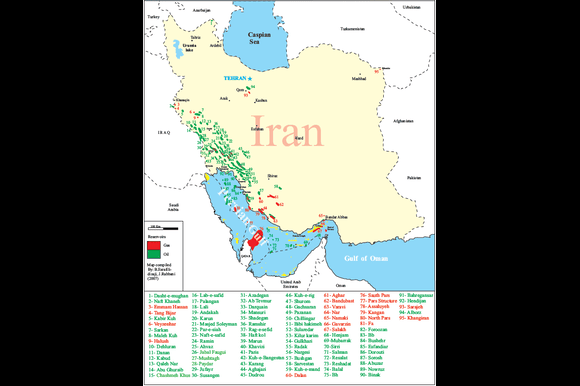
By Behrangaref -Wikipedia
Israel and Iran have entered a fifth consecutive day of cross-border attacks, with Israeli strikes now zeroing in on Iran’s most vital energy infrastructure. Targets have included Iran’s nuclear facilities, military installations, oil and gas assets, and even the headquarters of state television.
The ongoing escalation has sparked alarm over the possibility of a broader regional war and rising instability in global energy markets. Iran, a major global energy supplier, holds the world’s second-largest proven natural gas reserves and ranks third in proven crude oil reserves, according to the United States Energy Information Administration.
Iran’s Oil Industry: A Global Powerhouse Under Siege
With approximately 157 billion barrels of proven crude oil, Iran controls about 24 percent of the Middle East’s and 12 percent of the world’s total oil reserves. It is the ninth-largest oil producer globally and ranks fourth among the Organization of the Petroleum Exporting Countries (OPEC), pumping around 3.3 million barrels of crude oil daily.
The country exports close to 2 million barrels per day in crude and refined products. In 2023, Iran’s net oil export revenues were estimated at $53 billion, marking a significant increase from $37 billion in 2021. Despite a more diversified economy compared with its neighbors, oil remains a crucial pillar of government revenue. Years of sanctions and limited foreign investment, however, have hampered Iran’s ability to fully capitalize on its vast oil wealth.
Following the initial Israeli strikes on Friday, oil prices surged nearly 7 percent in a single day amid fears of a broader regional conflict. Prices have remained elevated since, reflecting market jitters over potential supply disruptions.
Strategic Oil Infrastructure at Risk
Iran’s oil infrastructure spans several critical regions, primarily in the south and west. This includes vast onshore and offshore oilfields, refineries, export terminals, and a sprawling pipeline network.
Kharg Island, Iran’s main crude export terminal, handles nearly 1.5 million barrels per day and serves as a strategic artery for the nation’s oil exports. The Strait of Hormuz, a narrow maritime chokepoint bordering Iran and Oman, sees over 20 percent of the world’s seaborne oil shipments pass through daily, making the region especially sensitive to military conflict.
Key onshore oilfields include the Ahvaz Field—one of the largest in the world—as well as Gachsaran, Marun, Agha Jari, Bibi Hakimeh, and Karanj, mostly situated in Khuzestan province. Offshore, Iran operates fields such as Abuzar, Foroozan, Doroud, and Salman, which are shared with neighboring Gulf states including Saudi Arabia and the UAE.
Iran’s major refineries include the historic Abadan Refinery—one of the oldest in the region—along with facilities in Tehran, Isfahan, Bandar Abbas, Arak, and Tabriz. These refineries support both domestic consumption and export needs.
Iran’s Gas Sector: A Critical Target
Iran also possesses the world’s second-largest proven natural gas reserves after Russia, estimated at 1,200 trillion cubic feet (34 trillion cubic metres). This accounts for 16 percent of the global total and 45 percent of all OPEC reserves.
The country ranks third in global gas production, following the United States and Russia. In 2023, Iran produced 9,361 billion cubic feet (265 billion cubic metres), contributing at least 6 percent to global supply.
Sanctions have forced Iran to rely primarily on domestic firms for the development of its gasfields, limiting access to foreign investment and advanced technology.
Iran’s gas infrastructure is largely concentrated in the south, particularly along the Gulf coast. The crown jewel of this sector is the South Pars gasfield—the largest in the world—which Iran shares with Qatar (where it is called the North Field). Other key fields include North Pars, Golshan, Ferdowsi, Kangan, and Nar. The South Pars Gas Complex in Bushehr province is the nation’s primary gas-processing hub.
Israeli Strikes Hit Key Energy Sites
Israeli forces have carried out targeted strikes on a number of critical Iranian energy facilities. Among the sites hit are the South Pars gasfield and Fajr Jam gas plant—central to Iran’s natural gas output. Also struck were the Shahran oil depot, the Shahr Rey oil refinery, and fuel depots in Tehran. These attacks are seen as a direct attempt to undermine Iran’s economic foundation and energy export capacity.
As hostilities continue to escalate, the targeting of Iran’s core energy infrastructure has not only deepened regional tensions but also heightened concerns about energy security and supply disruptions far beyond the Middle East.




